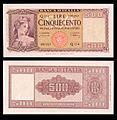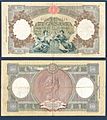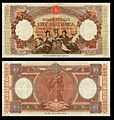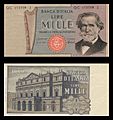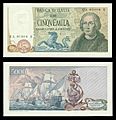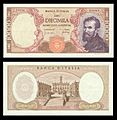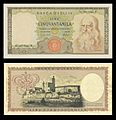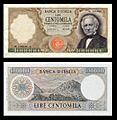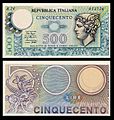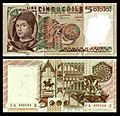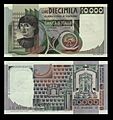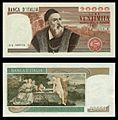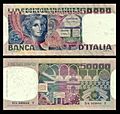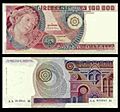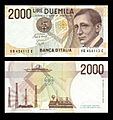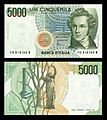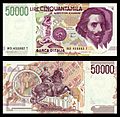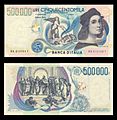Italian lira facts for kids
Quick facts for kids Italian lira |
|||||
|---|---|---|---|---|---|
|
|||||
| ISO 4217 Code | ITL | ||||
| User(s) | None, previously:
|
||||
| Inflation | 2.3% (2001) | ||||
| ERM | |||||
| Since | 13 March 1989, 25 November 1996 | ||||
| Withdrawn | 17 September 1992 | ||||
| Fixed rate since | 31 December 1998 | ||||
| Replaced by €, non cash | 1 January 1999 | ||||
| Replaced by €, cash | 1 March 2002 | ||||
| € = | Lit 1,936.27 | ||||
| Subunit | |||||
| 1⁄100 | Centesimo (withdrawn after World War II) |
||||
| Plural | lire | ||||
| Centesimo | centesimi | ||||
| Coins | |||||
| Freq. used | 50, 100, 200, 500, 1,000 lire | ||||
| Rarely used | 1 lira, 2, 5, 10, 20 lire | ||||
| Banknotes | |||||
| Freq. used | 1,000, 2,000, 5,000, 10,000, 50,000, 100,000 lire | ||||
| Rarely used | 20,000, 500,000 lire | ||||
| Printer | Istituto Poligrafico e Zecca dello Stato | ||||
The lira was the money used in Italy from 1861 until 2002. It was first created in 1807 by the Napoleonic Kingdom of Italy. This new money was similar to the French franc. Later, it was used by the different states that joined together to form the Kingdom of Italy in 1861.
The lira was divided into 100 smaller parts called centesimi. The word centesimi means "hundredths" or "cents." The lira was also used in the Albanian Kingdom for a short time.
The word "lira" comes from libra, an old money unit used in Europe for many centuries. This old system also gave us the French livre tournois (which led to the franc) and the pound in countries like the UK.
In 1999, the euro became Italy's main money unit. The lira then became a smaller part of the euro, with 1 euro being worth 1,936.27 lire. In 2002, euro coins and banknotes fully replaced the lira.
Contents
History of the Italian Lira
Where Did the Name "Lira" Come From?
The old money system, called the Carolingian system, divided the libra into 20 solidi or 240 denarii. In Italian, these became lira, soldo, and denaro. In English, they became pound, shilling, and penny.
The word "franc" was used in France for a coin worth one livre tournois. This term was also used in some parts of northern Italy to refer to the Italian lira.
How Was the Lira Written?
There wasn't one official symbol for the Italian lira. People used different abbreviations like Lit. (short for Lira italiana) or L. (short for Lira). Sometimes, symbols like ₤ or £ were also used. Banks often used Lit., which was known around the world.
You could also write the full name of the money, like "Lire 100,000" or "100,000 lire." The international code for the lira was ITL.
When Was the Lira First Used?
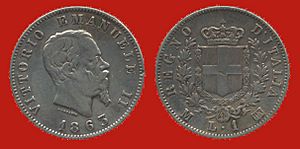
The Italian lira was first introduced in 1807 by the Napoleonic Kingdom of Italy. It was worth the same as the French franc. This new lira slowly replaced the different types of money used in various Italian states. This happened until Italy became one country in 1861.
For example, it replaced the money of places like Piedmont, Sardinia, Milan, Venice, and Tuscany. In 1865, Italy joined the Latin Monetary Union. This meant the lira was worth the same as the French, Belgian, and Swiss francs. Before 1914, about 5.18 Italian lire were equal to one U.S. dollar.
The Lira in the 20th Century
World War I caused prices in Italy to rise a lot. Later, Benito Mussolini, a leader in Italy, tried to control this. In 1926, he set a new exchange rate for the lira against the British Pound Sterling. This caused prices to drop for a while and created problems for the economy.
In 1927, the lira was linked to the U.S. dollar, with $1 being worth 19 lire. This rate stayed mostly the same until the 1970s. After World War II, the lira's value changed a lot. Italy then set the rate at $1 for 575 lire in 1947. This rate lasted until the early 1970s. After that, Italy experienced high inflation (prices rising quickly) until the euro was introduced.
The "Hard Lira" Idea
After World War II, the lira lost a lot of its value. This made it hard to count money because there were so many zeros. People suggested changing the money to remove some zeros, making it simpler. This idea was called the lira pesante (meaning "hard lira") or lira nuova ("new lira").
The plan was to make 1 "hard lira" equal to 1,000 old lire, removing three zeros. This project was put on hold several times because of ongoing inflation. It was finally stopped in 1991 when plans for a single European currency (the euro) became more serious.
How the Euro Replaced the Lira
The lira was Italy's official money until January 1, 1999. On that date, it was replaced by the euro. The lira officially became a smaller unit of the euro. Euro coins and banknotes started to be used in 2002.
Old lira money stopped being valid on February 28, 2002. The exchange rate was 1 euro for 1,936.27 lire. The Bank of Italy allowed people to exchange their old lira banknotes and coins for euros until December 6, 2011.
Italian Lira Coins

Coins from the Napoleonic Era
Between 1807 and 1813, the Napoleonic Kingdom of Italy made coins. These included copper coins for 1 and 3 centesimi, and 1 soldo (5 centesimi). There were also silver coins for 1, 2, and 5 lire, and gold coins for 20 and 40 lire. Most of these coins had a picture of Napoleon I.
Coins of the Kingdom of Italy (1861–1946)
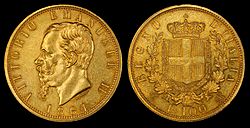
When Italy became a united kingdom in 1861, coins were made in different cities like Florence, Milan, Naples, and Turin. They included copper coins (1, 2, 5, 10 centesimi), silver coins (50 centesimi, 1, 2, 5 lire), and gold coins (10, 20 lire). In 1863, the silver coins worth less than 5 lire had less silver in them.
Coin production moved to Rome in the 1870s. Before World War I, the coins stayed mostly the same. After 1919, because the lira was worth less, new smaller coins were introduced. These included copper 5 and 10 centesimi, and nickel 50 centesimi, 1 lira, and 2 lire coins. Silver 5, 10, and 20 lire coins were also made.
In 1939, to save money, copper was replaced by aluminum bronze, and nickel by stainless steel. All coin making stopped in 1943 during the war. After 1943, the Allies (countries fighting against Germany) introduced their own money, called the AM-lira, which was used alongside regular Italian money until 1950.
Coins of the Italian Republic (1946–2002)
Coin production started again in 1946. By 1948, the lira was worth only 2% of its 1939 value. New aluminum coins were made for 1, 2, 5, and 10 lire. These were used with the AM-lire and some old coins.
In the mid-1950s, new stainless-steel coins for 50 and 100 lire were introduced. Aluminum-bronze 20 lire coins came in 1957, and silver 500 lire coins in 1958. The silver 500 lire coins became rare after 1967 because silver became more expensive.
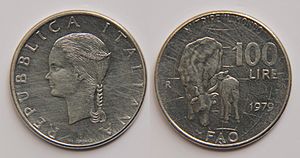
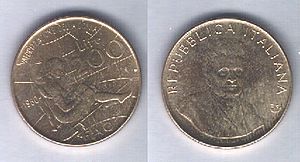
In 1977, 200 lire coins made of aluminum-bronze were introduced. In 1982, a special 500 lire coin was made from two different metals. This was the first coin made this way for general use. It also had its value written in braille for blind people.
Making 1 and 2 lire coins for everyday use stopped in 1959. Production of 5 lire coins was greatly reduced in the late 1970s and stopped in 1998. The 10 and 20 lire coins were also limited in 1991. The 50 and 100 lire coins were made smaller in 1990 and then redesigned in 1993. A 1,000 lire coin, also made of two metals, was introduced in 1997 but stopped in 1998 because the euro was coming.
The coins still being made for circulation when the euro arrived were:
- 1 lira (mostly for collectors)
- 2 lire (mostly for collectors)
- 5 lire (mostly for collectors)
- 10 lire (mostly for collectors)
- 20 lire (mostly for collectors)
- 50 lire
- 100 lire
- 200 lire
- 500 lire
- 1,000 lire
| Coins of the Italian lira | ||||||||
|---|---|---|---|---|---|---|---|---|
| Image | Value | Equivalent in euros | Diameter | Weight | Material | Obverse | Reverse | Dates of issue |
| 1 lira | €0.0005 | 17.2 mm | 0.625 g | Aluminium | Weighing scales; text "REPVBBLICA ITALIANA" | "1"; Cornucopia | 1951-2001 | |
| 2 lire | €0.001 | 18.3 mm | 0.8 g | Aluminium | Bee; text "REPVBBLICA ITALIANA" | "2"; Olive branch | 1953-2001 | |
| 5 lire | €0.0026 | 20.2 mm | 1.0 g | Aluminium | Rudder; text "REPVBBLICA ITALIANA" | "5"; Dolphin | 1951-2001 | |
| 10 lire | €0.0052 | 23.25 mm | 1.6 g | Aluminium | Plough; text "REPVBBLICA ITALIANA" | "10"; Two ears of wheat | 1951-2001 | |
| 20 lire | €0.0103 | 21.25 mm | 3.6 g | Bronzital | Profile of a woman at left with ears of wheat in her hair; text "REPVBBLICA ITALIANA" | "L 20"; Oak branch | 1957-2001 | |
| 50 lire | €0.0258 | 24.8 mm | 6.25 g | Acmonital | Profile of a woman at right with oak wreath; text "REPVBBLICA ITALIANA" | "L 50"; god Vulcan beating iron on an anvil | 1954-1989 | |
| 50 lire | €0.0258 | 17 mm | 2.7 g | Acmonital | Profile of a woman at right with oak wreath; text "REPVBBLICA ITALIANA" | "L 50"; god Vulcan beating iron on an anvil | 1990-1995 | |
| 50 lire | €0.0258 | 19.2 mm | 4.5 g | Copper-nickel | Profile of a woman at left with a towered crown and hair swathed in fabric; text "REPVBBLICA ITALIANA" | Text "50 LIRE"; a bunch of grapes, a laurel branch, an oak branch, a cornucopia and a gear | 1996-2001 | |
| 100 lire | €0.0516 | 27.8 mm | 8 g | Acmonital | Profile of a woman at left with a laurel crown; text "REPVBBLICA ITALIANA" | "L 100"; goddess Minerva holding an olive tree and a long spear | 1955-1989 | |
| 100 lire | €0.0516 | 18.20 mm | 3.30 g | Acmonital | Profile of a woman at left with a laurel crown; text "REPVBBLICA ITALIANA" | "L 100"; goddess Minerva holding an olive tree and a long spear | 1990-1992 | |
| 100 lire | €0.0516 | 22 mm | 4.5 g | Copper-nickel | Profile of a woman at left with a towered crown and hair swathed in fabric; text "REPVBBLICA ITALIANA" | Text "100 LIRE"; a bird in flight, a wheat stalk, a dolphin and an olive branch | 1993-2001 | |
| 200 lire | €0.1033 | 24 mm | 5.0 g | Bronzital | Profile of a woman at right; text "REPVBBLICA ITALIANA" | Text "200 LIRE" within a gear wheel | 1977-2001 | |
| 500 lire | €0.2582 | 29.3 mm | 11 g | .835 silver | Christopher Columbus's ships the Nina, Pinta and Santa Maria; text "REVBBLICA ITALIANA", "L. 500" | Bust of a woman in Renaissance dress, representing Italy, surrounded by 19 shields | 1958-2001 | |
| 500 lire | €0.2582 | 25.8 mm | 6.8 g | Bi-metallic (Bronzital center plug in an acmonital outer ring) | Profile of a woman at left with wings; text "REPVBBLICA ITALIANA" | Piazza del Quirinale in Rome; "L. 500" | 1982-2001 | |
| 1,000 lire | €0.5165 | 27 mm | 8.8 g | Bi-metallic (Copper-nickel center plug in bronzital outer ring) | Profile of a woman at left with a towered crown and hair swathed in fabric; text "REPVBBLICA ITALIANA" | Map of Europe; "L. 1000" | 1997-2001 | |
Italian Lira Banknotes
In 1882, the Italian government started printing low-value paper money called "Biglietto di Stato" (State Ticket). These were 5 and 10 lire notes, and sometimes 25 lire notes. The government also issued "Buono di Cassa" (Cash Vouchers) for 1 and 2 lire.
The Bank of Italy started printing paper money in 1896. Their first notes were for 50, 100, 500, and 1,000 lire. After World War II, the Bank of Italy introduced 5,000 and 10,000 lire notes.
In 1951, the government issued notes again, simply called "Repubblica Italiana." These were 50 and 100 lire notes, which were later replaced by coins. In 1966, 500 lire notes were introduced, also replaced by a coin in 1982.
The Bank of Italy introduced higher value notes: 50,000 and 100,000 lire in 1967. Then came 2,000 lire notes in 1973, 20,000 lire notes in 1975, and finally 500,000 lire notes in 1997.
In the 1970s, when small coins were hard to find, Italian banks issued "miniassegni". These were like small checks but were used as money for small change.
The banknotes in use when the euro was introduced were:
- 1,000 lire, featuring Maria Montessori (€0.516)
- 2,000 lire, featuring Guglielmo Marconi (€1.03)
- 5,000 lire, featuring Vincenzo Bellini (€2.58)
- 10,000 lire, featuring Alessandro Volta (€5.16)
- 20,000 lire, featuring Tiziano Vecellio (€10.32)
- 50,000 lire, featuring Gian Lorenzo Bernini (€25.82)
- 100,000 lire, featuring Caravaggio (€51.65)
- 500,000 lire, featuring Raffaello (€258.23)
| Image | Value | Dimensions | Equivalent in euros (€) |
Main colors | Obverse | Reverse | Watermark |
|---|---|---|---|---|---|---|---|
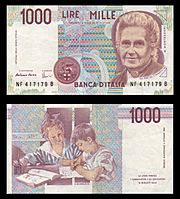 |
1,000 lire | 112 x 62 mm | €0.516 | Red-violet | Maria Montessori | Montessori education | Maria Montessori |
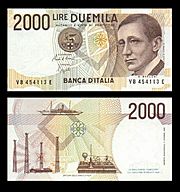 |
2,000 lire | 118 x 60 mm | €1.03 | Dark brown | Guglielmo Marconi | Marconi's yacht "Elettra"; Radio towers at Marconi's station Glace Bay in Nova Scotia; telegraph | Guglielmo Marconi |
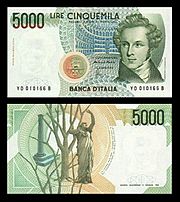 |
5,000 lire | 126 x 70 mm | €2.58 | Olive-green and blue | Vincenzo Bellini; interior of Teatro Massimo Bellini (Catania) | Scene from Bellini's opera "Norma"; Allegory of "Lyrics" | Vincenzo Bellini |
 |
10,000 lire | 133 x 70 mm | €5.16 | Dark blue | Alessandro Volta; the Voltaic pile | The Tempio Voltiano Museum in Como | Alessandro Volta |
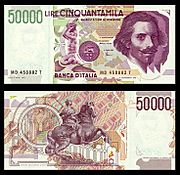 |
50,000 lire | 150 x 70 mm | €25.82 | Red-violet or Violet and dull green | Gian Lorenzo Bernini; Triton Fountain in Rome | Equestrian statue (by Bernini), interior of St. Peter's Basilica (Vatican City) | Gian Lorenzo Bernini |
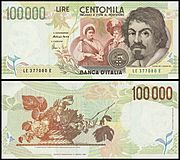 |
100,000 lire | 156 x 70 mm | €51.65 | Dark brown, reddish brown and pale green | Caravaggio, couple from Caravaggio's painting "The Fortune Teller" | Fruit basket in the background | Caravaggio (Michelangelo Merisi) |
 |
500,000 lire | 163 x 78 mm | €258.23 | Deep purple, dark blue and bright green | Raffaello; Triumph of Galatea | The School of Athens | Raphael |
Gallery
- Banknotes circulating in 1951
- Banknotes circulating in 1971
- Banknotes circulating in 1982
- Banknotes circulating in 2000
Other Currencies Like the Italian Lira
Vatican City Lira
The Vatican lira was the official money of Vatican City. It was worth the same as the Italian lira. Italian lira notes and coins could be used in Vatican City, and Vatican coins could be used in Italy and San Marino.
Vatican City also switched to the euro at the same time as Italy. Like their old lira coins, Vatican City now has its own special euro coins.
San Marino Lira
The Sammarinese lira was the official money of San Marino. Just like the Vatican lira, it was worth the same as the Italian lira.
Italian lira notes and coins were valid in San Marino, and San Marino coins could be used in Italy and Vatican City. San Marino also switched to the euro with Italy. They also have their own euro coins.
What Were Miniassegni?
Miniassegni were a type of temporary money used in Italy in the late 1970s. At that time, small coins were hard to find. People often used candy, stamps, or even public transport tickets instead of small change.
The first miniassegni appeared in December 1975. Many banks then started issuing them. They came in small values like 50, 100, 150, 200, 250, 300, and 350 lire.
Efforts to Bring Back the Lira
In 2005, a political group called the Lega Nord started a campaign to bring back the lira. They wanted it to be used alongside the euro. In 2014, Beppe Grillo, the leader of another political group called the Five Star Movement, also suggested the same idea.
See also
 In Spanish: Lira italiana para niños
In Spanish: Lira italiana para niños
- Economy of Italy
- Italian euro coins
- Economy of San Marino
- Sammarinese euro coins
- Economy of Vatican City
- Vatican euro coins




